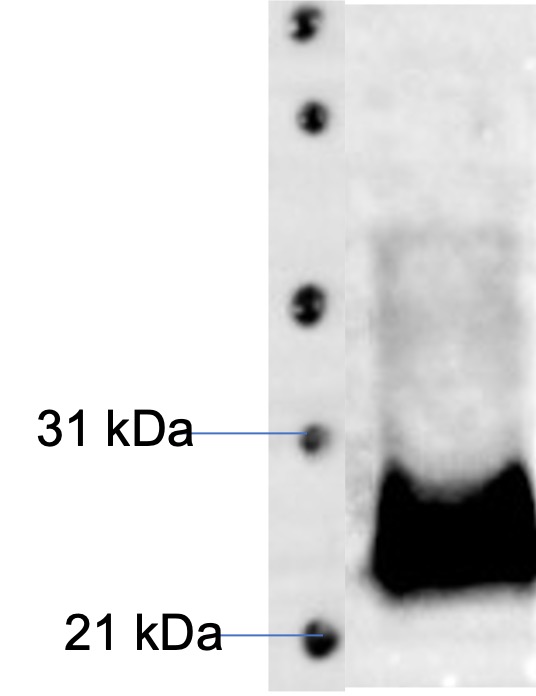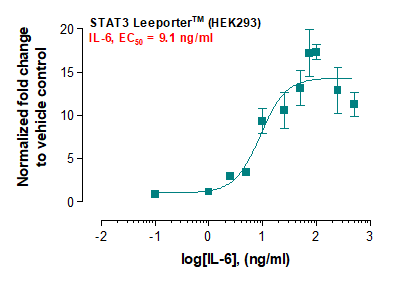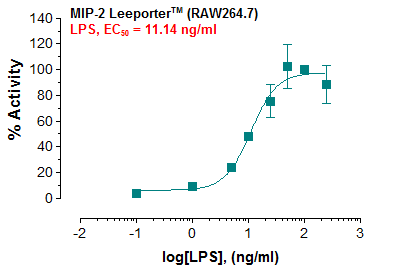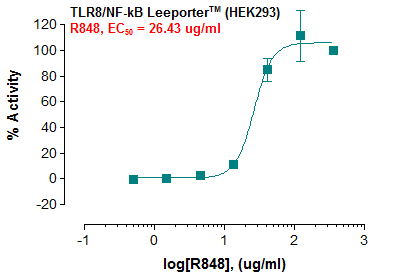MDA5/NF-kB Leeporter™ Luciferase Reporter-HEK293T Cell Line

Fig-1: Induction of MDA5 activity by poly(I:C) prepacked with lipofectamine in MDA5 Leeporter™ - HEK293T cells.
Roll over image to zoom in
Shipping Info:
Order now and get it on Tuesday January 06, 2026
Same day delivery FREE on San Diego area orders placed by 1.00 PM
| Amount : | 1 Vial |
| Content : | Each vial contains 2 ~ 3 x 10^6 cells in 1 ml of 90% FBS + 10% DMSO. |
| Storage condition : | Immediately upon receipt, store in liquid nitrogen. |
The MDA5 Leeporter™ Luciferase Reporter cell line is a stably transfected HEK 293T cell line which expresses human melanoma differentiation-associated protein-5 (MDA5) and Renilla luciferase reporter gene under the transcriptional control of an NF-kB response element. As a dsRNA helicase enzyme, MDA5 is encoded by the IFIH1 gene. MDA5 is one of the RIG-I-like receptors (RLRs) that are a family of DExD/H box RNA helicases including MDA5, RIG-I and LPG2, which play a major role in pathogen sensing of RNA virus infection to initiate and modulate antiviral immunity. RLR expression is typically maintained at low levels in resting cells but is greatly increased during inflammation, specifically with IFN exposure and after virus infection. MDA5 detects cytoplasmic dsRNA generated during viral replication unlike Toll-like receptor 3 (TLR3) which can detect phagocytosed dsRNA in endosomes. MDA5 also responds to poly(I:C), the synthetic analog of viral dsRNA. The MDA5 activation by poly(I:C) is shown in Figure 1.
Application:
- Monitor the MDA5 signaling pathway activity.
- Screen for activators or inhibitors of the MDA5 signaling pathway.
Culture conditions:
To passage the cells, detach cells from culture vessel with Trypsin/EDTA, add complete growth medium and transfer to a tube, spin down cells, resuspend cells and seed appropriate aliquots of cells suspension into new culture vessels. Subcultivation ration = 1:10 to 1:20 weekly. To achieve satisfactory results, cells should not be passaged over 16 times.
Functional validation:
A. Response of MDA5 Leeporter™ – HEK293T cells to Poly(I:C).
LIMITED USE RESTRICTIONS:
THIS PRODUCT IS SOLELY FOR IN VITRO RESEARCH USE ONLY. NOT FOR DIAGNOSTIC OR THERAPEUTIC USE.
By use of this product, user agrees to be bound by the terms of this limited use statement.
This product is solely for Internal Research Purposes and not for Commercial Purposes. Commercial Purposes include, but are not limited to (1) use of the cell line in manufacturing; (2) use of the cell line to provide a service, information or data; (3) use of the cell line for therapeutic, diagnostic or prophylactic purposes; or (4) resale of the cell line whether or not such cell lines are resold for use in research. The buyer cannot sell, give or otherwise transfer this product to a third party.
Commercial License Agreement is available for non-research use if applicable. Please contact Abeomics ([email protected]).
For Research Use Only. Not for use in diagnostic/therapeutics procedures.
|
There are currently no product reviews
|

















.png)













